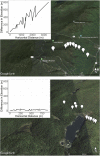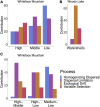Elevational Gradients Impose Dispersal Limitation on Streptomyces
- PMID: 35592003
- PMCID: PMC9113539
- DOI: 10.3389/fmicb.2022.856263
Elevational Gradients Impose Dispersal Limitation on Streptomyces
Abstract
Dispersal governs microbial biogeography, but the rates and mechanisms of dispersal remain poorly characterized for most microbial taxa. Dispersal limitation is driven by limits on dissemination and establishment, respectively. Elevation gradients create striking patterns of biogeography because they produce steep environmental gradients at small spatial scales, and these gradients offer a powerful tool to examine mechanisms of dispersal limitation. We focus on Streptomyces, a bacterial genus common to soil, by using a taxon-specific phylogenetic marker, the RNA polymerase-encoding rpoB gene. By targeting Streptomyces, we assess dispersal limitation at finer phylogenetic resolution than is possible using whole community analyses. We characterized Streptomyces diversity at local spatial scales (100 to 3,000 m) in two temperate forest sites located in the Adirondacks region of New York State: Woods Lake (<100 m elevation change), and Whiteface Mountain (>1,000 m elevation change). Beta diversity varied considerably at both locations, indicative of dispersal limitation acting at local spatial scales, but beta diversity was significantly higher at Whiteface Mountain. Beta diversity varied across elevation at Whiteface Mountain, being lowest at the mountain's base. We show that Streptomyces taxa exhibit elevational preferences, and these preferences are phylogenetically conserved. These results indicate that habitat preferences influence Streptomyces biogeography and suggest that barriers to establishment structure Streptomyces communities at higher elevations. These data illustrate that Streptomyces biogeography is governed by dispersal limitation resulting from a complex mixture of stochastic and deterministic processes.
Keywords: assembly; bacterial; biogeography; community; diversity; microbial; soil.
Copyright © 2022 Hariharan and Buckley.
Conflict of interest statement
The authors declare that the research was conducted in the absence of any commercial or financial relationships that could be construed as a potential conflict of interest.
Figures







Similar articles
-
A Latitudinal Diversity Gradient in Terrestrial Bacteria of the Genus Streptomyces.mBio. 2016 Apr 12;7(2):e02200-15. doi: 10.1128/mBio.02200-15. mBio. 2016. PMID: 27073097 Free PMC article.
-
Phylogenetic conservatism of thermal traits explains dispersal limitation and genomic differentiation of Streptomyces sister-taxa.ISME J. 2018 Sep;12(9):2176-2186. doi: 10.1038/s41396-018-0180-3. Epub 2018 Jun 7. ISME J. 2018. PMID: 29880909 Free PMC article.
-
Biogeographic Patterns and Assembly Mechanisms of Bacterial Communities Differ Between Habitat Generalists and Specialists Across Elevational Gradients.Front Microbiol. 2019 Feb 11;10:169. doi: 10.3389/fmicb.2019.00169. eCollection 2019. Front Microbiol. 2019. PMID: 30804920 Free PMC article.
-
Integrating species traits into species pools.Ecology. 2018 Jun;99(6):1265-1276. doi: 10.1002/ecy.2220. Ecology. 2018. PMID: 29569239 Review.
-
Measuring biodiversity to explain community assembly: a unified approach.Biol Rev Camb Philos Soc. 2011 Nov;86(4):792-812. doi: 10.1111/j.1469-185X.2010.00171.x. Epub 2010 Dec 14. Biol Rev Camb Philos Soc. 2011. PMID: 21155964 Review.
References
LinkOut - more resources
Full Text Sources

